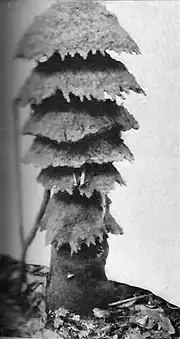Cubitermitinae
The Cubitermitinae are an Afrotropical subfamily of higher termites with 28 known genera and 147 species.[1][2][3][4] The nests of most taxa are either subterranean or found within the mounds of other termite species. The most well known genus of this subfamily is Cubitermes, which commonly build epigeal nests with one or more caps used to shield the nest against rainfall, giving them a characteristic mushroom shape.[5] Most members of this subfamily are soil-feeders.
| Cubitermitinae | |
|---|---|
 | |
| Mushroom-shaped nest of Cubitermes sp. | |
| Scientific classification | |
| Domain: | Eukaryota |
| Kingdom: | Animalia |
| Phylum: | Arthropoda |
| Class: | Insecta |
| Order: | Blattodea |
| Infraorder: | Isoptera |
| Family: | Termitidae |
| Subfamily: | Cubitermitinae Weidner, 1956: 99 |
Identification
The gut of workers have a specialized blind caecum/diverticulum connected to proctodeal 3 and a complex physiology that regulates the pH and oxygen supply in the gut compartments.[6][5]
Soldiers have a generally subrectangular head capsule with a projection anterior to the frontal gland with the fontanelle being conspicuous and sunken in a pit or groove. The labrum is strongly bifurcated and the antennae have 14 - 15 articles (antennomeres).[5]
Genera
The following genera are currently recognized:[4]
- Apilitermes
- Basidentitermes
- Batillitermes
- Crenetermes
- Cubitermes
- Euchilotermes
- Fastigitermes
- Furculitermes
- Isognathotermes
- Lepidotermes
- Megagnathotermes
- Mucrotermes
- Nitiditermes
- Noditermes
- Okavangotermes
- Ophiotermes
- Orthotermes
- Ovambotermes
- Pilotermes
- Polyspathotermes
- Proboscitermes
- Procubitermes
- Profastigitermes
- Ternicubitermes
- Thoracotermes
- Trapellitermes
- Unguitermes
- Unicornitermes
References
- Weidner, H. 1956. Contributions to the knowledge of termites in Angola, mainly based on the collections and observations of A. de Barros Machado (I. Contribution). Publicações Culturais da Companhia de Diamantes de Angola 29: 55-106.
- "Termites (Isoptera): Their Phylogeny, Classification, and Rise to Ecological Dominance". American Museum Novitates (3650): 1. 2009-07-25. doi:10.1206/651.1. ISSN 0003-0082. S2CID 56166416.
- ENGEL, MICHAEL S.; KRISHNA, KUMAR (2004). <0001:fnfti>2.0.co;2 "Family-Group Names for Termites (Isoptera)". American Museum Novitates (3432): 1. doi:10.1206/0003-0082(2004)432<0001:fnfti>2.0.co;2. ISSN 0003-0082. S2CID 86672880.
- Engel, M.S. (2011). "Family-group names for termites (Isoptera), redux". ZooKeys (148): 171–184. doi:10.3897/zookeys.148.1682. PMC 3264418. PMID 22287896.
- Treatise on the Isoptera of the world. (Bulletin of the American Museum of Natural History, no. 377). Krishna, Kumar.; Grimaldi, David A.; Krishna, Valerie.; Engel, Michael S. Volume 1; Page 123
- Brune, Andreas (March 2014). "Symbiotic digestion of lignocellulose in termite guts". Nature Reviews Microbiology. 12 (3): 168–180. doi:10.1038/nrmicro3182. ISSN 1740-1534. PMID 24487819. S2CID 5220210.